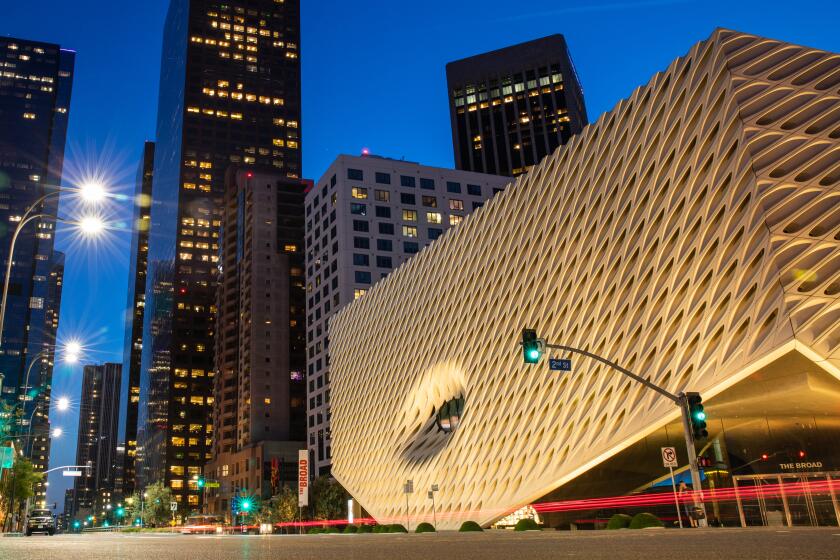Remolding a Mexican Ceramic Tradition
- Share via
In the mid-1970s, a San Diego man named Spencer Heath McCallum wandered into a secondhand store in southern New Mexico. A trained anthropologist, he’s also a dedicated junk-shop addict. In this one, he found three ceramic vessels. Their design suggested prehistoric origins but looked new. Intrigued, McCallum bought them. His curiosity ignited a quest that eventually resulted in the Southwest Museum’s current exhibition, “New Dimensions: Casas Grandes-Style Pottery.”
The exhibition, organized by curator Rose Figueroa, is installed in a smallish gallery and consists of vitrines containing some 100 ceramics by various artists. The story of how they got there is set out in detail in a related catalog by Walter P. Parks, “The Miracle of Mata Ortiz: Juan Quezada and Potters of Northern Chihuahua.”
Briefly summarized, McCallum was so impressed with his pots that he set out to find their maker. The trail led into Mexico. McCallum thought at first he was looking for a woman, since they tend to be the domestic potters down south. Instead, he found Juan Quezada, a laborer, living with his family in Mata Ortiz, a village of some 2,000 souls about 150 miles south of the border.
At the time, Quezada was in his mid-30s. Since youth, he’d been fascinated by shards of prehistoric ceramics found while gathering firewood. He didn’t know it at the time, but his village is located not far from ruins of satellite habitations of the ancient city of Pacquime, about 15 miles north. The fragmentary prototypes that Quezada unearthed were remnants of pieces made there for about 250 years, starting around AD 1250.
Mesmerized, Quezada slowly rediscovered the technology and aesthetic of the original thin-walled Casas Grandes ceramics. The single-handed effort required about 15 years. Very modest sales encouraged him, his family and neighbors to hope that ceramic work might be a way out of the dead economics that ruled their lives. Quezada taught his skills to friends and relatives, but little recognition resulted until McCallum turned up and decided to champion Quezada’s art among the cognoscenti.
Today, the village boasts some 300 potters and a reportedly lively ceramics trade. Thus, the “miracle” of Mata Ortiz designates one of the economic variety. Aesthetic considerations are another matter.
The exhibition reveals Quezada as impressive. His containers are those elegantly simplified gourd-like forms familiar to the genre. Surface decoration borders on the astonishing. One polychromed bottle uses a black background as support for a pattern made up of small tan squares ranked into curved bands. They track the bulging and recession of the support, drawn in perspective dramatizing and exaggerating the form until the pattern seems to break loose and float inside the surface.
Evidently, Pacquime was a courtly and aristocratic center with the stylized art that often results in such cultures. Thus, Quezada’s revival leans closer to virtuosity than the soulfulness of, say, the Mimbres people. Even at that, works like several polychromed ollas take on a magical quality.
Quezada’s line forms interrupted geometric patterns that move rapidly across the surface like ancestors of really gifted automobile pin-striping. Wrapping around the surface of a three-dimensional object, they seem to lift off and become highly abstracted visual metaphors of the forces of nature whirling around the planet. The effect is clearly conscious, since one of the artist’s lithographs is titled “Wind.”
A flask by Macario Ortiz employs a sophisticated, almost Asian, black-on-black technique that achieves variation by using color shiny-against-matte to create an animal motif hovering somewhere between lizard and fish.
For inexplicable reasons, most attempts of this art to deal with containers shaped like humans or animals just don’t work very well. Ancient West Mexican art of this variety had an amazing capacity to infuse clay with animal life. The closest thing here is a jar in the shape of a hare by Nicholas Ortiz. Contrary to expectation, it bears less resemblance to traditional pre-Columbian art and more to a Disney version of “Alice in Wonderland.” It acts as a reminder that any attempt to bring back the past will invariably be stamped by the present.
* Southwest Museum, 234 Museum Drive; through Sept. 21, closed Mondays and major holidays, (213) 221-2164.






